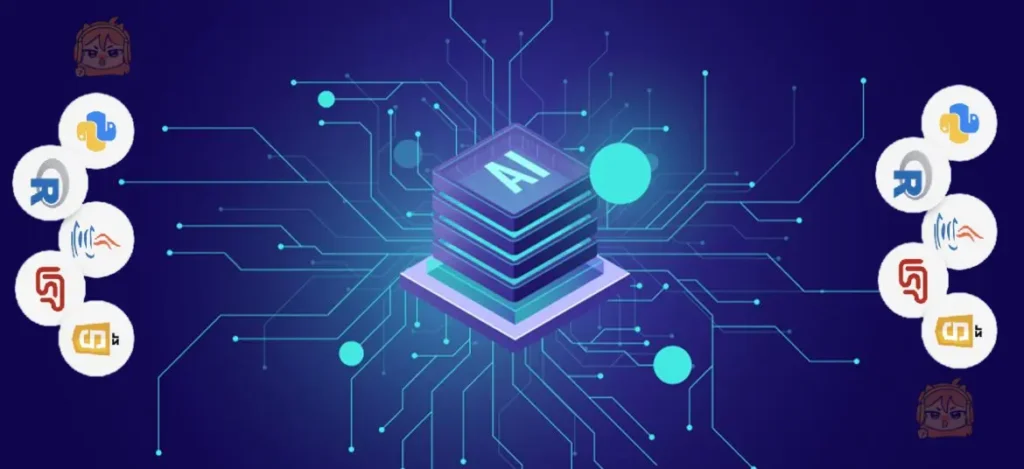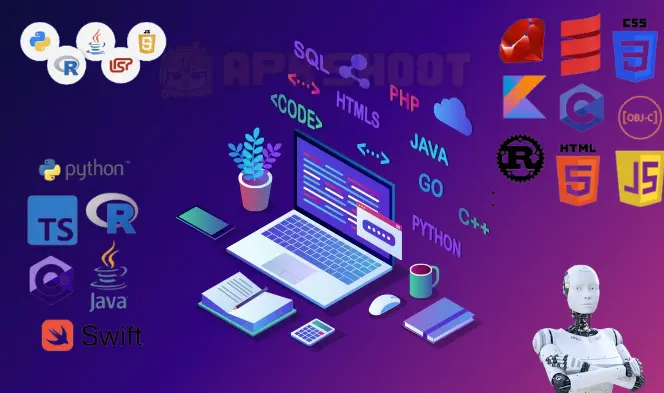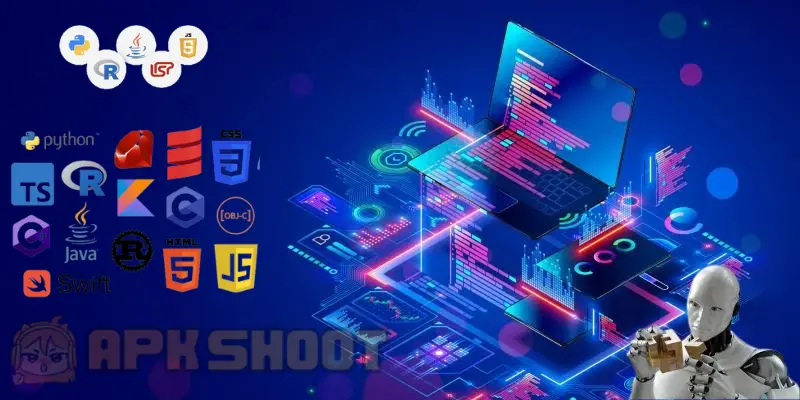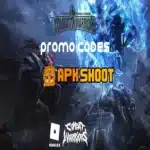Artificial intelligence (AI) is fast-expanding scientific research that can potentially transform the world we live in. The potential for AI applications is limitless, due to advances in machine learning as well as deep learning approaches. Artificial intelligence (AI) is becoming an essential component of modern technology. AI has transformed the way we engage with technology, from self-driving vehicles to virtual assistants. Programming languages are an essential part of AI. The correct AI programming language may substantially influence the performance and efficiency of AI systems. However, selecting the correct programming language is one of the most critical considerations when designing an AI system. In this post, APKShoot will look at the best programming languages for AI and analyze their advantages and disadvantages.
Introduction
Artificial intelligence is the development of intelligent systems capable of doing activities that would typically need human intelligence. Such systems need a mixture of programming abilities, knowledge of machine learning, and an extensive understanding of the field in which the AI system will work. Choosing the appropriate programming language is an important component of AI development.

Artificial Intelligence
Artificial Intelligence is a branch of computer science with the objective of developing intelligent machines that can operate and execute tasks like humans. It involves developing algorithms and computer programs capable of learning from data, seeing patterns, and making judgments. Robotics, natural language processing, image and audio recognition, and autonomous vehicles are all examples of AI applications.
Importance of Choosing The Best Programming Languages for AI
Choosing the correct programming language may have a considerable influence on an AI system’s performance, speed, and efficiency. Some programming languages are more appropriate for specific AI tasks, while others are more general-purpose and may be utilized for a variety of AI applications. The selection of programming language will depend on the particular needs of the AI system that is being created.
1. Python: The Most Popular Language for AI
Python is the most popular programming language for AI development. It is the best programming language for machine learning and artificial intelligence It is a high-level, interpretive language that is simple to learn and has a huge development community. TensorFlow, Keras, and PyTorch are just a few of the AI-specific modules and frameworks available in Python. These libraries provide pre-built functions and classes that may be used for applications such as image recognition, natural language processing, and deep learning.
Existing Python libraries and frameworks are as follows
- Pandas
- SciPy
- Keras
- Theano
- scikit-learn
- nltk
- PyTorch
2. Lisp
Lisp (historically stylized as LISP) is one of the oldest and best ai programming languages in circulation for AI development. Lisp, which was created in 1958, is an abbreviation for list processing, one of its initial applications. By 1962, and with the assistance of its developer, John McCarthy, the language had progressed to the point where it could solve artificial intelligence challenges.
The language is still capable today, but because of its complex syntax and extensive libraries, developers rarely choose Lisp first. Having said that, there are a number of AI projects where Lisp skills might be quite useful, which includes Rapid prototyping, Executing data structures as programs, Mandatory waste collection, and many more. Overall, Lisp is recognized in recent history for being extremely adaptable and capable of translating ideas into reality.
Features of Lisp
- Rapid prototyping
- Modifying programs as data
- Executing data structures as programs
- Mandatory garbage collection
- Dynamic object creation

3. Java: A Robust Language for AI
Java is a popular programming language that is widely used in enterprise software development. It is a general-purpose language that is known for its robustness, scalability, and security. Java has several libraries and frameworks that can be used for AI development, including Deeplearning4j and DL4J. Java is also a popular choice for developing AI applications that need to be deployed on large-scale systems.
4. R: A Language for Data Science and AI Research
R is a computer language that was developed primarily for data analysis and statistical computation. It is commonly utilized in academic research and is well-known in data science. Caret and MLR are two R libraries and packages that are specially built for AI and machine learning. For academics working on data-driven AI projects, R is a good choice.
You might be interested in the following R packages:
- Gmodels offers model fitting tools.
- Tm is a text-mining application framework.
- OneR is a classification used to accomplish the One Rule Machine Learning classification.
5. C++: The Language for High-Performance Computing in AI
C++ is a high-performance programming language that is frequently utilized in applications requiring quick and efficient processing. It is a general-purpose programming language that may be used for a variety of AI applications such as computer vision and robotics. OpenCV and Boost are two C++ libraries and frameworks that are specially built for AI. C++ is a remarkable programming language for developing AI applications that dictate high-performance processing.
6. Julia: The Newcomer with High Performance and Ease of Use
Julia is a relatively new programming language that is gaining attention in the field of artificial intelligence. It is a high-performance programming language intended for scientific computing and numerical analysis. Flux and Knet are two Julia libraries and frameworks that are specially developed for AI. These features make the transfer to Julia simple for researchers who are already familiar with MATLAB.
Julia’s speed is one of its primary assets. Julia’s just-in-time (JIT) compilation enables it to attain C++-like speed while still being simple to create and comprehend. Julia also provides strong parallel processing capabilities, allowing it to make use of contemporary multicore CPUs and GPUs.
Julia also stands out for its uncomplicated nature. Julia features a straightforward and simple syntax that is easy to learn, especially for inexperienced programmers. Julia’s REPL (read-eval-print loop) also makes it simple to test and debug programs interactively.
While Julia is still a new language, it is gaining popularity in the AI field. Many researchers are starting to utilize Julia for their AI projects, and there is an active developer community working on Julia libraries and AI frameworks.
In terms of AI creation, Julia comes preloaded with preset models, algorithms and numerous packages for statistical programming, such as
- MLJ.jl
- Flux,jl
- Turing,jl
- Metalhead
7. MATLAB: A Language for Prototyping and Research
MATLAB is a widely used programming language in education and research. It is a high-level language that is simple to learn and has a wide number of users. The Deep Learning Toolbox and the Computer Vision Toolbox are two MATLAB toolboxes and libraries that are specially developed for AI and machine learning.
One of the benefits of MATLAB is its simplicity. MATLAB offers a straightforward and clear syntax that is simple to learn, especially for beginners. The interactive nature of MATLAB also makes it simple to create and test AI systems.
Another benefit of using MATLAB is its visualization capabilities. MATLAB includes extensive data visualization and analysis features that may be used to explore and analyze AI systems.
While MATLAB is a popular prototype and research language, it may not be the greatest choice for implementing AI systems in production. The performance of MATLAB is not as excellent as that of other languages, and it might be costly to license.

8. Prolog
Prologue, an abbreviated form of logic programming, has been around since 1972. Prologue, despite its age, works effectively for the proper tasks. Instead of employing coded sequences, you just sketch down a basic set of facts, rules, goals, and questions in the Prologue. As a result, Prologue excels in pattern matching, particularly when NLP is used. For example, the first chatbot in history was called ELIZA and was created in Prologue.
ELIZA’s capacity to assign values to words and organize them to construct a question was greatly aided by Prolog’s logic framework.
Prolog’s basic principles are listed below
- Facts clarify true statements
- Rules clarify statements with extra requirements
- Goals clarify where the submitted statements are placed given the available information
- Queries clarify how to make statements accurate and the final evaluation of facts and rules
Surprisingly, these basics lie at the heart of Prolog’s power. Nowadays, cloud technology allows chatbots to access a vast database of fresh and old information. That implies chatbots are far more clever than they were during the Prologue era.
9. Rust
Everyone wants high-performance, rapid, and secure software development, and Rust can help you. It’s a programming language with a wide range of applications that AI developers love to use. Rust’s syntax is identical to C++’s, except the former provides memory safety and precludes garbage collection.
Rust powers the backends of several well-known services, including Dropbox, Yelp, Firefox, Azure, Polkadot, Cloudflare, npm, Discord, and others. Rust is an excellent choice for AI development and scientific computing because of its memory safety, speed, and ease of expression.
10. Haskell
Haskell is a fully functional programming language that is statically typed. In summary, Haskell is both versatile and expressive.
Its abstraction ability reduces the need for consuming large amounts of time for solving problems and errors. Haskell’s efficient memory management, type system, and code reuse practices only contribute to its allure. However, one of Haskell’s most fascinating characteristics is that it is a lazy programming language. Therefore, Haskell evaluates code only when necessary. Of course, depending on how you look at it, this may be a pro or a drawback. Overall, Haskell’s attraction to AI engineers stems from the language’s efficiency. You’ll be doing more deliberately than typing.
11. JavaScript: A Language for Web-Based AI Applications
JavaScript is a popular programming language that is widely used in web development. Although it is not the first option for AI development, JavaScript may be utilized to create AI apps that operate in the browser.
TensorFlow.js and Brain.js are two JavaScript libraries and frameworks that may be utilized for AI development. These libraries provide pre-built methods and classes that may be used for applications such as image recognition and natural language processing.
One of JavaScript’s advantages is its widespread use. Because JavaScript is supported by all current web browsers, AI applications written in JavaScript may operate on a broad variety of devices without the need for extra software.
Another benefit of JavaScript is its adaptability. JavaScript may be used for a variety of web-based AI applications, including chatbots and recommendation engines.
Conclusion
There’s no one-size-fits-all answer when it comes to the best programming language for AI development. Every language has its own advantages and drawbacks. Choosing the right programming language is a critical aspect of AI development. Each programming language has its own strengths and weaknesses, and the choice of language will depend on the specific requirements of the AI system being developed. Python is currently the most popular language for AI development, but there are several other languages, including Java, R, C++, Julia, MATLAB, and JavaScript, that can be used for developing AI applications.
Related Articles
FAQ
The best programming language for AI will depend on the particular requirements of the AI system that is being created. Python is now the most common language for AI development, however, other languages such as Java, R, C++, Julia, MATLAB, and JavaScript may also be used to create AI systems.
No, while Python is the most popular programming language for AI, other programming languages such as R, Java, and C++ are also used.
Yes, AI systems often use multiple programming languages for different components of the system.
Python is an excellent programming language for beginners in AI due to its simplicity and readability.
Python is a great place to start, thanks to its versatility, ease of use, and extensive library collection.
While a computer science background can be helpful, it’s not necessarily a requirement. Many successful AI developers come from diverse backgrounds, including mathematics, physics, and even art.
Absolutely! Many AI projects require multiple languages to achieve the desired outcome.










